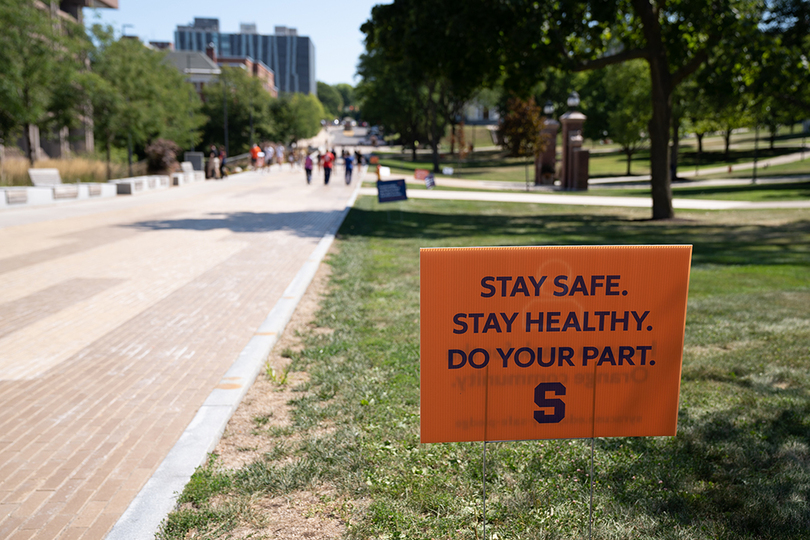Here is how SU’s COVID-19 response strategy compares to other schools

Other colleges have temporarily shut down their campuses or called off the in-person semester entirely. Emily Steinberger | Photo Editor
The Daily Orange is a nonprofit newsroom that receives no funding from Syracuse University. Consider donating today to support our mission.
Syracuse University will have finished its first week of in-person instruction since March 13 on Friday. This is the same amount of time students at the University of North Carolina at Chapel Hill spent on its campus before the university sent them home due to a coronavirus outbreak.
While colleges across the country spent the summer making decisions about how to welcome students back to campus, several ended up making last-minute changes to their plans. For schools like UNC-Chapel Hill and the University of Notre Dame, COVID-19 cases spiking within the first weeks of residential learning led to a complete shutdown of campus.
Here’s how SU’s response to COVID-19 compares to schools that had to close their doors early:
The breaking point
UNC closed its campus and cancelled residential learning Aug. 17, about a week after its first day of classes. At the time, the percentage of positive cases on campus had jumped from 2.8% to 13.6% in a single week, and there were four “COVID clusters” among UNC students, according to The Daily Tar Heel. The university reported 135 positive cases the day before closing.
UNC’s COVID-19 dashboard showed that 177 students were in isolation at the time and 349 students were quarantining.
Less than a day after UNC’s announcement, Notre Dame announced that it would move all courses online for at least two weeks due to a COVID-19 outbreak on campus. At the time, the university reported that 146 students and one employee had tested positive for the virus.
There were only three active COVID-19 cases among SU students and employees in the central New York area as of Monday, and 12 students were in quarantine. Vice Chancellor Mike Haynie, who has spearheaded SU’s COVID-19 response, has said that the university has 200 quarantine and isolation units to house students who contract or come in contact with the virus.
Although SU has yet to see a serious surge of COVID-19 cases, the university has organized its response to a potential outbreak into five levels of campus shutdown procedures. The number of available quarantine and isolation units are at the forefront of SU’s decision making.
If SU identifies more than 100 students who may have been exposed to COVID-19, the university will begin a shelter-in-place order and move all classes online until the virus has been contained. If the university’s confidence in its ability to trace additional cases of COVID-19 deteriorates, it would move into the fourth level, moving all programs online and confining students to their dorms or individual floors.
SU will enter level five — the final stage of the shutdown — when there is “no realistic strategy” to contain the virus. The university would ask students living on-campus to move out of university housing as soon as possible.
Testing strategies
SU students had to provide proof of a negative COVID-19 test within 10 days of their arrival on campus. Once students came to campus, the university conducted a pooled saliva test, in which students’ samples were grouped by housing assignment and tested for traces of COVID-19.
While Notre Dame also had all students provide proof of a negative test before they arrived on campus, the university did not conduct any testing once students came to campus, according to a university news release.
UNC did not require students to get tested before coming to campus and did not test them when they arrived. The university encouraged its students to take preventative measures to combat the virus both before and upon arrival on campus, according to The Daily Tar Heel.
UNC started at a “disadvantage” compared to SU, said David Larsen, an associate professor and environmental epidemiologist at SU. Larsen served on SU’s Public Health and Emergency Management Subcommittee, the group tasked with advising administrators about the health implications of reopening.
How cases spread
While Notre Dame reported that several of its positive cases were from students living off campus and likely spread from off-campus gatherings, UNC traced many of its cases to “COVID clusters” in three residence halls and one off-campus fraternity.
After over 100 freshmen gathered Wednesday night on SU’s Quad, Haynie said the students could have sparked an outbreak that would shut down residential classes before they began. But Haynie on Sunday cited new testing data that showed all the students’ pooled saliva tests had come back negative.
Haynie added, however, that false negative test results remain a possibility and that he couldn’t rule out the possibility of the virus spreading as a result of the gathering.
The biggest factor in the outbreaks at UNC and Notre Dame was the COVID-19 transmission rate in the surrounding areas, Larsen said. The transmission rates in areas around schools that were forced to close early could be 10 to 30 times higher than in Onondaga County, he said.
“We wouldn’t try this if we were in the same situation as UNC and Notre Dame were,” Larsen said.





